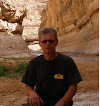
Great Zimbabwe Ruins, or the Great Zimbabwe National Monument is the largest stone structure in Africa outside Egypt. The subject is a national monument and UNESCO World Heritage Site since 1986.
The city was the capital of the Kingdom of Zimbabwe that existed in 1100-1400. It is believed that there could be up to 18,000 inhabitants then.
The model of The great Zimbabwe complex in the National Museum of Bulawayo. In the complex there are two nearby located buildings - Hill Complex and the Great Enclosure.

Hill Complex

Great Enclosure
Upon arrival it was raining, so that is why these images are a bit grayish.

Hill Complex - the first view through a light rainfall. The king lived up there.


And then the stairway is taking up between two big rocks. The place is very narrow and just suitable for protection against enemies.

Almost at top.


And then back down. The Great Enclosure, downtown.


The walls are 250 meters long and up to 11 feet high.

The Conical tower. Unknown till today what was the purpose of this kind of a stone tower.
Some other facts about this strange place: the name "Zimbabwe" has come from the Shona language, dzimba mabwe mabwe means "house of stone".
Great Zimbabwe was abandoned in 1450 for unknown reasons. The next capital was Khami, which is now also in ruins. During the time of colonization the general idea was that these buildings were built either by the Phoenicians or the Arabs, but not by the local tribes. During the 1930s it had even been required to state that they were built by the whites. The current view is that these constructions were still built by the forebeares of the native tribes. During the time of independence these ruins or "Zimbabwe" became a national symbol and in the year of 1980 the state of Rhodesia was renamed into Zimbabwe.
Since there is now known no written history of Great Zimbabwe – a lot of issues are still a mystery - such as how these structures were built in Zimbabwe, while in the neighbourhood only huts of clay were put up. There are about 200 ruins of this kind of small towns in Zimbabwe.

And now, another place worth visiting near Harare, Chiremba Balancing Rocks, also called the Epworth Rocks in some places.

There is a guard at the gate and a ticket seller, guide service is not offered, there are no giraffe-sellers . No visitors either .

Thatś the way they are, nobody has lifted or moved them.

And somewhere here there should be some more very important rocks. I drive around, but cannot find.


Finally I took out a picture with the help of which it is it more convenient to search further.

Found! The right ones. These three rocks are the symbol of Zimbabwe's central bank. I am putting here this copy-paste from the Internet, "The Importance of rocks have assumed a symbolic as a Seal of the Reserve Bank of Zimbabwe and, in this context are, the naturalism represents financial stability, banking stability, and strength."
The center of Harare (formerly Salisbury).


Traffic is sparse, perhaps because it is Sunday, but still sparse. Or, perhaps the streets are too wide.
In Zimbabwe the common currency is U.S. dollar, so all the prices are in dollars.
The price of one liter diesel is $1,3 – it means a little less than 1 Euro, and it has happened a few times that while wishing to refuel, the answer is that there is no diesel today. A box of eggs (30 pieces) costs 5 USD at a shop, the price of half a pound of ice cream is 2.3 USD. Onions and tomatoes are available by the road for a dollar. No sense to buy products that are grown at the spot from a shop.
In the morning I went to the Mozambique Embassy to find out the matter of visas. In the net did not find anything meaningful, except to confirm that the prices of visas have changed, and not to the direction of decreasing. Could not find any specific pricing. In general, it should be possible to get the visa at the border as well , but definitely it is better to have it done before, will take less time at the border. At the Embassy there were less than 10 people waiting in the queue .
I handed over my passport. Estonia was unknown, then another officer was consulted, and the decision was the Estonians are allowed to enter the country. Then I was told that the visa now costs 110 USD. And that was that. The highest price for a visa during this trip, so far the most expensive was the Malawi visa - 100 USD. And I didn`t want to miss Mozambique, so tomorrow to the Embassy . And then straight on the road again.



No comments:
Post a Comment